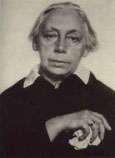Kنthe Kollwitz
(July 8, 1867 - 22 April 1945)

Kنthe Kollwitz was born in Kِnigsberg, Prussia. The home was a religious one. Her father had been a judge, but resigned his position and turned “back to the people” because he could not hope to meet out true justice under Frederic Wilhelm IV, “the worst of all Prussian kings”. Deeply imbued with sympathy for the suffering and with ideas of social justice, Kنthe was immediately attracted by the naturalistic movement which, permeated with socialist ideas, became the decisive force in literature in the late eighties. Neither her teacher in theBerlin school for women artists, Stauffer-Bern, nor the impressionists whom she met during her two-year stay in Munich showed her the way she was seeking in art. Struck by the paintings of Max Klinger and Fritz von Uhde, she discovered her artistic mission. Once she had found it, she went far beyond these two painters in her presentation of the people, their hunger, love, sickness, strength and despair. Her work summarised the complaints of the oppressed in one great indictment.
When she married in 1891, her father advised her “to be a wife and mother and to abandon her career.” Her husband Dr. Karl Kollwitz, was a physician who had set up a practice in one of the poorest districts of the Berlin slums. Giving unstintingly of himself, he worked long crowded hours for low fees or none, and his wife driven by her desire to help the unfortunate, worked by his side. Thus her marriage only stimulated her anew. It was during this period that her distinctly feminine art developed to full strength, nourished by a motherly heart, which Kنthe Kollwitz poured into her paintings, etchings and drawings.
Statue of Kollwitz in East Berlin
Her work, though profoundly political in its implication, rarely trespassed beyond the realm of emotional empathy. Grief stares from the eyes of helpless children at the deathbed of their mother, despair cries out wordlessly from the face of the mothers who wait in the doctor’s anteroom. Only in a few of her pictures does she indicate also the hope of a way out.
It is not surprising that the rich patrons who patronised pleasant, comfortable art did not appreciate her stirring paintings and etchings. Her pictures were rejected by juries of art exhibitions until, in 1893; she joined with Edward Munch and a few others in an independent exhibition. It was impossible to overlook the artist, but when she was suggested for the Silver Medal of the Groكe Kunstausstellung in Berlin ( The Great Art Exhibition), Wilhlem II withheld his permission.
In the First World War Kنthe Kollwitz lost her only son in action. For a long time thereafter she considered designing a war memorial, but felt incapable of moulding her personal grief into the ideas of national heroism. She finally built a private memorial, the figures of two mourning parents, a magnificent work of massive greatness and simplicity. The Nazis silenced Kنthe Kollwitz when they came to power. In 1933 she was forced to resign her place on the faculty of theAcademy of Arts (she was its first female member).
Her early prints were mainly etchings but after 1910 she worked in lithography, producing wonderfully nuanced images off her stones and also produced some monumentally great woodcuts.
Taken from:
http://www.wolman-prints.com/pages/artistbiog/all/k/113.html
http://www.spartacus.schoolnet.co.uk/ARTkollwitz.htm
http://www.wolman-prints.com/pages/thumbnails/all/k/113.html
http://en.wikipedia.org/wiki/Kathe_Kollwitz